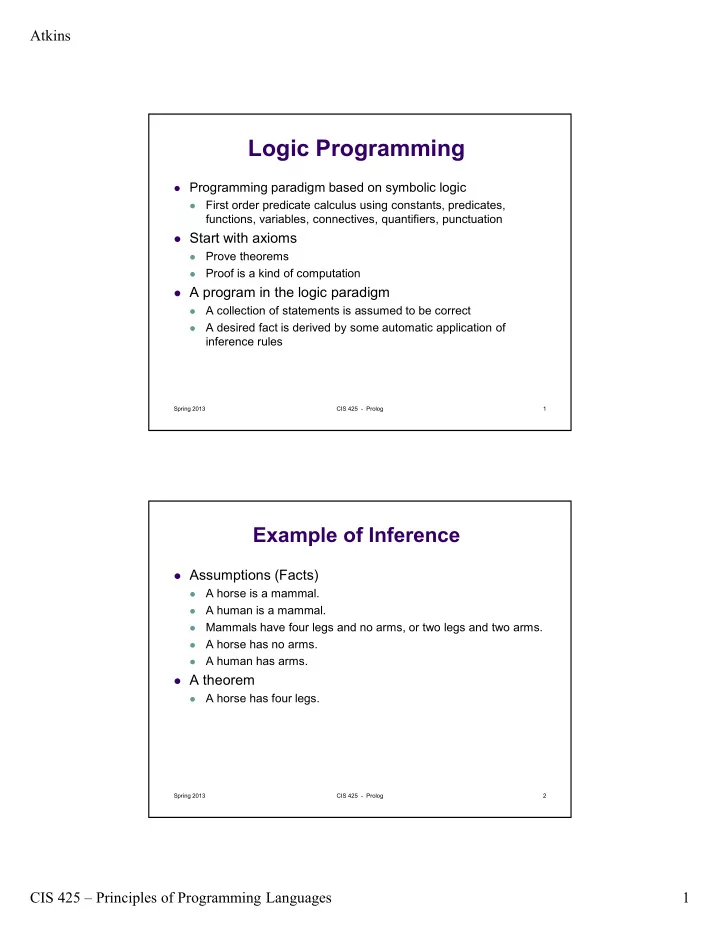

Atkins Logic Programming � Programming paradigm based on symbolic logic First order predicate calculus using constants, predicates, � functions, variables, connectives, quantifiers, punctuation � Start with axioms Prove theorems � Proof is a kind of computation � � A program in the logic paradigm A collection of statements is assumed to be correct � A desired fact is derived by some automatic application of � inference rules Spring 2013 CIS 425 - Prolog 1 Example of Inference � Assumptions (Facts) A horse is a mammal. � A human is a mammal. � Mammals have four legs and no arms, or two legs and two arms. � A horse has no arms. � A human has arms. � � A theorem A horse has four legs. � Spring 2013 CIS 425 - Prolog 2 CIS 425 – Principles of Programming Languages 1
Atkins As Horn Clauses � Horn clauses are implications: head ← body, where body is a collection of simple statements � Truth of body implies truth of head � � Examples mammal(horse). An axiom is a head with empty body. � mammal(human). � legs(x,2) ← mammal(x), arms(x,2) � legs(x,4) ← mammal(x), arms(x,0) � arms(horse,0) . � � Query (theorem to be proved) ← legs(horse,4) � Spring 2013 CIS 425 - Prolog 3 Resolution and Unification � Resolution inference rule: If we have two clauses and head of first matches statement in the � body of the second, then we can replace it by the body of the first Example: suppose we have two clauses � b ← a � c ← b � � Then we can infer c ← a � Essentially, we combine heads and bodies, then cancel matching � statements on both sides � Unification – pattern matching to make statements identical Variables set to patterns, i.e., variables are instantiated � Spring 2013 CIS 425 - Prolog 4 CIS 425 – Principles of Programming Languages 2
Atkins Using Resolution and Unification Given � mammal(horse). � arms(horse,0) . � legs(x,2) ← mammal(x), arms(x,2) � legs(x,4) ← mammal(x), arms(x,0) � Query � ← legs(horse,4) � Inference � Use 4 th rule to get: legs(x,4) ← mammal(x), arms(x,0), legs(horse,4) � Match x to horse: legs(horse,4) ← mammal(horse), arms(horse,0), legs(horse,4) � Cancel to get: ← mammal(horse), arms(horse,0) � Use 1 st rule: mammal(horse) ← mammal(horse), arms(horse,0) � Cancel to get: ← arms(horse,0) � Use 2 nd rule: arms(horse,0)← arms(horse,0) � Cancel to get: ← , which shows the query is true. � Spring 2013 CIS 425 - Prolog 5 A more program like example Greatest common divisor � Given � gcd(u,0,u). (the gcd of a number and zero is that number) � gcd(u,v,w) ← not zero(v), gcd(v, u mod v, w). (the gcd of two numbers is the same � as the gcd of the second and the mod of the two) Query � ← gcd(15,10,x) � Inference � 2 nd rule, unification: gcd(15,10,x) ← not zero(10), gcd(10,15 mod 10,x),gcd(15,10,x) � Cancel to get: ← not zero(10), gcd(10,15 mod 10,x) � Use arithmetic, basic properties: ← gcd(10,5,x) � 2 nd again: gcd(10,5,x) ← not zero(5), gcd(5,10 mod 5,x),gcd(10,5,x) � Cancel to get: ← not zero(5), gcd(5,10 mod 5,x) � Simplify again: ← gcd(5,0,x) � This matches first rule (with x=5): gcd(5,0,5) ← gcd(5,0,5) ,so answer x=5 is true � Spring 2013 CIS 425 - Prolog 6 CIS 425 – Principles of Programming Languages 3
Atkins Prolog � Widely used logic programming language Based on Horn clauses � Uses linear depth first strategy � � Interpreted � Syntax Use :- for implications � Variables capitalized � Builtin arithmetic � List types – enclosed in [] like ML, but ‘|’ instead of ‘::’ � Comparison dicey – must force evaluation using 'is' � Statements terminated with period � 'consult' used to read assertions, ‘halt’ to exit � Spring 2013 CIS 425 - Prolog 7 Prolog Example � File 'gcd' contains gcd(U,0,U). gcd(U,V,W) :- (V=\=0), R is U mod V, gcd(V, R, W). � A Prolog session ?- consult('gcd'). % gcd compiled 0.00 sec, 464 bytes true. ?- gcd(15,10,X). X = 5 . ?- gcd(96,5,X). X = 1 . ?- gcd(96,60,X). X = 12 . ?- Spring 2013 CIS 425 - Prolog 8 CIS 425 – Principles of Programming Languages 4
Atkins Another Prolog Example File 'append' contains � append([], Y, Y). append([H|X], Y, [H|Z]) :- append(X,Y,Z). Prolog session � ?- consult('append'). % append compiled 0.00 sec, 540 bytes true. ?- append([a,b],[c,d,e], [a,b,c,d,e]). true. ?- append([a,b],[c,d,e],X). X = [a, b, c, d, e]. ?- append([a,b],X,[a,b,c,d]). X = [c, d]. ?- append(X, [d,c], [a,b,c,d]). false. Spring 2013 CIS 425 - Prolog 9 CIS 425 – Principles of Programming Languages 5
Recommend
More recommend